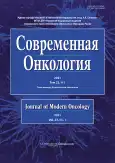Can any breast skin thickening be staged as T4?
- Authors: Amosova V.A.1, Petrovskii A.V.1,2, Karpova M.S.1, Ponedel’nikova N.V.1, Frolova M.A.1
-
Affiliations:
- Blokhin National Medical Research Center of Oncology
- Sechenov First Moscow State Medical University (Sechenov University)
- Issue: Vol 23, No 3 (2021)
- Pages: 466-469
- Section: CLINICAL ONCOLOGY
- URL: https://journals.rcsi.science/1815-1434/article/view/64964
- DOI: https://doi.org/10.26442/18151434.2021.3.200907
- ID: 64964
Cite item
Full Text
Abstract
Data analysis showed that many diagnostic issues in breast cancer patients with skin involvement are not systematized. In some cases when the tumor is small and skin involvement symptoms are minimal ("local" skin edema), should this category of patients be considered as patients with non-inflammatory skin involvement breast cancer? Current research confirms the presence of skin involvement has much less prognostic value than, for example, tumor size or lymph node metastases, and the surgical term "unresectable" may not always be adequate. In addition, clinical data often do not correspond to pathological data, which also complicates the staging and leads to "overtreatment" of such patients. Thus, further research is needed to identify categories of breast cancer (patients with skin involvement similar in prognosis, as well as to individualize approaches to local and systemic treatment.
Keywords
Full Text
##article.viewOnOriginalSite##About the authors
Viktoriia A. Amosova
Blokhin National Medical Research Center of Oncology
Author for correspondence.
Email: amosova_va@mail.ru
ORCID iD: 0000-0001-7207-631X
SPIN-code: 4726-5951
oncologist
Russian Federation, MoscowAleksandr V. Petrovskii
Blokhin National Medical Research Center of Oncology; Sechenov First Moscow State Medical University (Sechenov University)
Email: amosova_va@mail.ru
ORCID iD: 0000-0002-7514-280X
SPIN-code: 5441-2747
Scopus Author ID: 36949543000
Cand. Sci. (Med.)
Russian Federation, MoscowMarina S. Karpova
Blokhin National Medical Research Center of Oncology
Email: amosova_va@mail.ru
ORCID iD: 0000-0002-4945-982X
Graduate Student
Russian Federation, MoscowNataliia V. Ponedel’nikova
Blokhin National Medical Research Center of Oncology
Email: amosova_va@mail.ru
ORCID iD: 0000-0002-8047-3523
Cand. Sci. (Med.)
Russian Federation, MoscowMona A. Frolova
Blokhin National Medical Research Center of Oncology
Email: amosova_va@mail.ru
ORCID iD: 0000-0002-8149-0085
SPIN-code: 2809-7737
Cand. Sci. (Med.)
Russian Federation, MoscowReferences
- NCCN Guidelines Version 2.2021 Breast Cancer.
- Van der Auwera I, Van den Eynden GG, Colpaert CG, et al. Tumor lymphangiogenesis in inflammatory breast carcinoma: a histomorphometric study. Clin Cancer Res. 2005;11:7637-42.
- Edge SB, American Joint Committee on Cancer, American Cancer Society. AJCC cancer staging handbook: from the AJCC cancer staging manual. 7th ed. New York: Springer, 2010.
- Sardanelli F, Boetes C, Borisch B, et al. Magnetic resonance imaging of the breast: recommendations from the EUSOMA working group. Eur J Cancer. 2010;46(8):1296-316.
- Harms K, Wittekind C. Prognosis of women with pT4b breast cancer: the significance of this category in the TNM system. Eur J Surg Oncol. 2009;35(1):38-42.
- Wiggett WS, Louw M, Karusseit VO. The histology of peau d’orange in breast cancer – what are the implications for surgery? S Afr J Surg. 2012;50(3):75-8.
- Güth U, Singer G, Schötzau A, et al. Scope and significance of non-uniform classification practices in breast cancer with non-inflammatory skin involvement: a clinicopathologic study and an international survey. Ann Oncol. 2005;16(10):1618-23.
- Silverman D, Ruth K, Sigurdson ER, et al. Skin involvement and breast cancer: are T4b lesions of all sizes created equal? J Am Coll Surg. 2014;219(3):534-44.
- Zucali R, Kenda R. Small Size-T4 Breast-Cancer. Natural History and Prognosis. Tumori. 1981;67(3):225-30.
- Güth U, Wight E, Schötzau A, et al. A new approach in breast cancer with non-inflammatory skin involvement. Acta Oncol. 2006;45(5):576-83.
- Mateo AM, Mazor AM, DeMora L, et al. Patterns of Care and Efficacy of Chemotherapy and Radiotherapy in Skin-Involved Breast Cancers of All Sizes. Clin Breast Cancer. 2019;19(4):292-303.
Supplementary files











